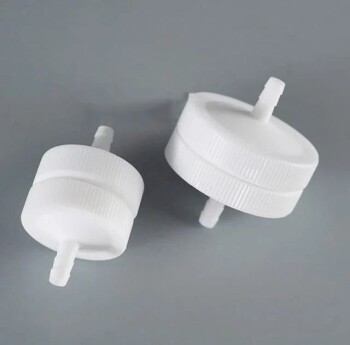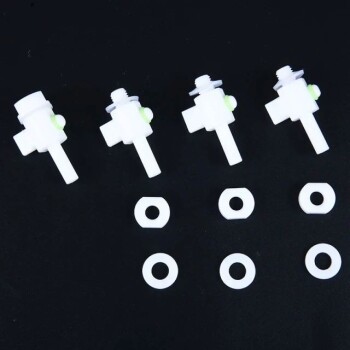Introduction aux filtres optiques
Définition et concepts de base
Un filtre filtre optique est un dispositif spécialisé conçu pour manipuler la transmittance ou la réflectance de la lumière en fonction de sa longueur d'onde, de sa polarisation ou de sa distribution spatiale. Ces filtres jouent un rôle crucial dans divers systèmes optiques en laissant passer sélectivement certaines longueurs d'onde et en en bloquant d'autres. Cette transmission ou réflexion sélective est obtenue par différents mécanismes, chacun adapté à des applications spécifiques.
Les filtres à densité neutre, par exemple, sont un type de filtre optique qui présentent une dépendance minimale à l'égard de la longueur d'onde. Contrairement à d'autres filtres qui peuvent interagir fortement avec des longueurs d'onde spécifiques, les filtres à densité neutre atténuent la lumière de manière uniforme sur un large spectre. Cette caractéristique les rend idéaux pour les applications nécessitant une réduction uniforme de la lumière sans modifier la composition spectrale de la source lumineuse.
La fonctionnalité des filtres optiques va au-delà de la simple sélection de la longueur d'onde. Les filtres peuvent également être conçus pour affecter l'état de polarisation de la lumière, transformant une lumière à polarisation linéaire en une lumière à polarisation circulaire ou vice versa. En outre, les filtres spatiaux peuvent manipuler la distribution spatiale de la lumière, souvent utilisée dans les systèmes d'imagerie pour améliorer la qualité de l'image en supprimant les fréquences spatiales indésirables.
Il est essentiel de comprendre ces concepts de base pour apprécier les applications et les types de filtres optiques dans les sections suivantes.
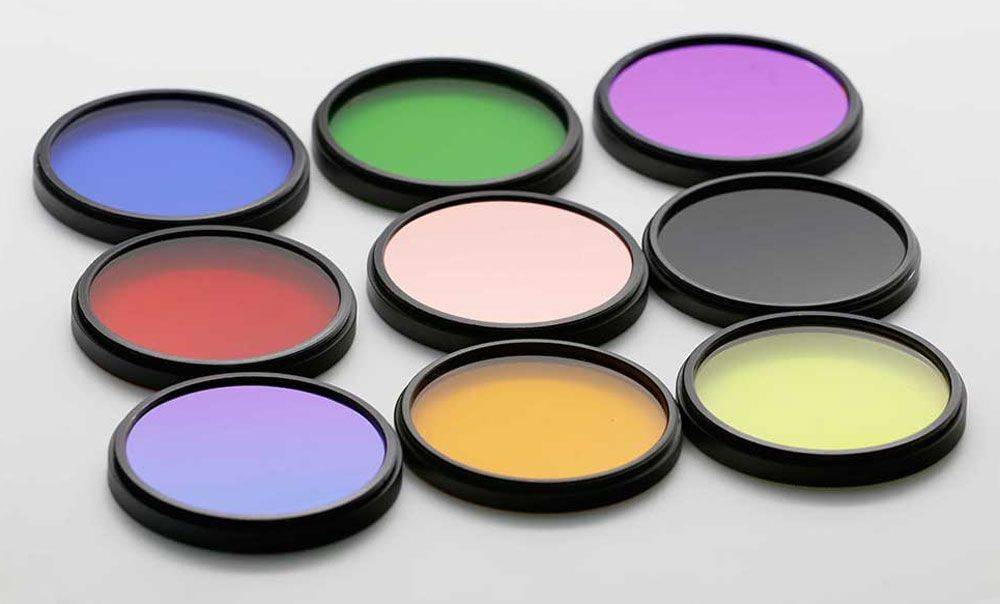
Types de filtres optiques
Filtres à absorption
Les filtres à absorption sont une catégorie de filtres optiques qui absorbent sélectivement la lumière à des longueurs d'onde spécifiques, bloquant efficacement les fréquences indésirables tout en laissant passer les fréquences souhaitées. Ce type de filtre est essentiel dans diverses applications optiques, allant de la simple correction des couleurs à l'analyse spectrale complexe.
Types de filtres à absorption
-
Filtres en verre à absorption: Ces filtres sont fabriqués à partir de verre coloré qui absorbe certaines longueurs d'onde de la lumière et en transmet d'autres. Ils sont couramment utilisés en photographie et dans les instruments scientifiques pour la correction des couleurs et l'analyse spectrale.
-
Filtres à colorant: Fabriqués à partir de colorants organiques incorporés dans un support transparent, ces filtres offrent une grande efficacité d'absorption et sont souvent utilisés dans les systèmes laser et la spectroscopie optique.
-
Filtres de couleur: Généralement utilisés dans la photographie et le traitement d'images, les filtres de couleur laissent passer des couleurs spécifiques tout en en bloquant d'autres, ce qui permet un contrôle et une amélioration précis des couleurs.
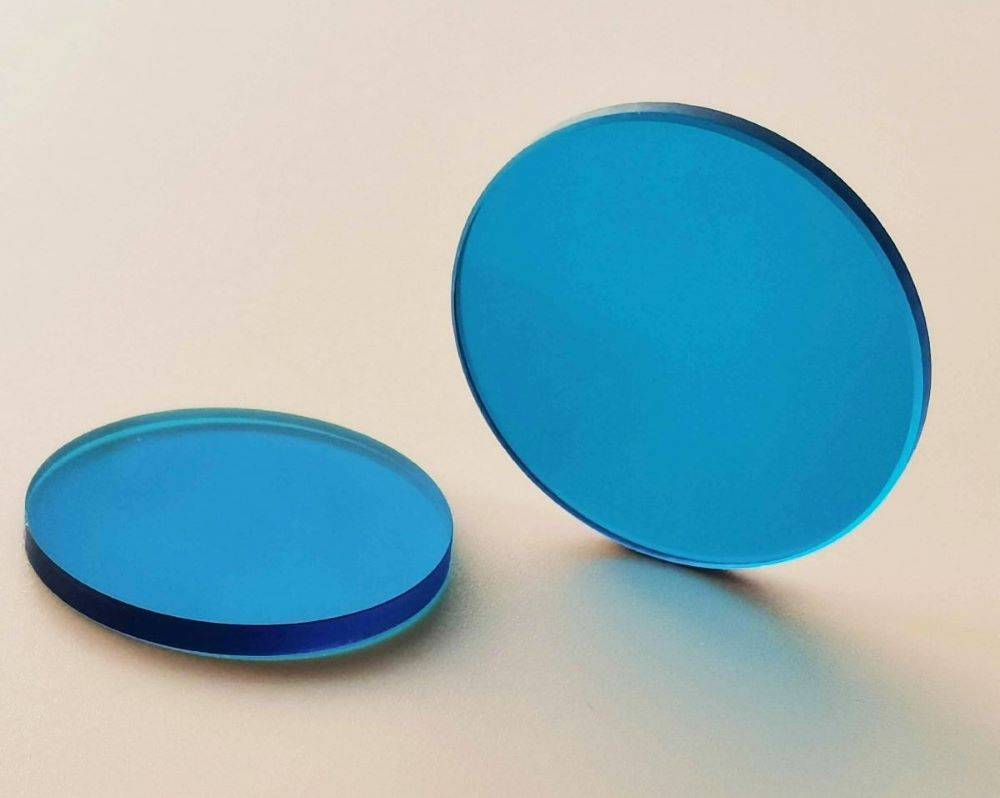
Mécanisme d'absorption
Le processus d'absorption dans ces filtres est régi par l'interaction entre la lumière incidente et la structure électronique des matériaux. Lorsque la lumière d'une longueur d'onde spécifique frappe le filtre, elle excite les électrons à des niveaux d'énergie plus élevés, convertissant l'énergie lumineuse en chaleur ou en d'autres formes d'énergie, réduisant ainsi l'intensité de la longueur d'onde absorbée.
Applications
- Photographie: Utilisé pour améliorer ou modifier la balance des couleurs des photographies.
- Instruments scientifiques: Essentiels dans les spectromètres et autres outils d'analyse pour isoler des longueurs d'onde spécifiques de la lumière.
- Systèmes laser: Ils permettent de régler la longueur d'onde et de supprimer les longueurs d'onde indésirables.
Les filtres basés sur l'absorption sont indispensables pour garantir la précision et l'efficacité des systèmes optiques en contrôlant précisément le spectre lumineux.
Filtres basés sur les interférences
Les filtres à base d'interférence exploitent les principes d'interférence des ondes pour transmettre ou réfléchir sélectivement la lumière à des longueurs d'onde spécifiques. Ces filtres fonctionnent en introduisant des déphasages entre les ondes lumineuses, ce qui peut être réalisé par divers mécanismes tels que les revêtements électrolytiques, les filtres de bord et les réseaux de Bragg.
Revêtements électrolytiques
L'une des principales méthodes de filtrage par interférence consiste à utiliser des revêtements électrolytiques. Ces revêtements sont conçus pour créer une fine pellicule sur la surface du filtre, qui modifie la phase des ondes lumineuses incidentes. Lorsque la lumière traverse le revêtement, des interférences constructives et destructives se produisent, ne laissant passer que certaines longueurs d'onde et en bloquant d'autres. Cette technique est particulièrement efficace dans les applications nécessitant une sélection précise des longueurs d'onde, telles que les systèmes laser et l'analyse spectroscopique.
Filtres de bord
Les filtres de bord sont un autre composant essentiel du filtrage basé sur les interférences. Ces filtres sont conçus pour transmettre la lumière sur une large gamme de longueurs d'onde tout en réfléchissant des longueurs d'onde spécifiques sur les bords de la bande de transmission. La conception des filtres de bord implique souvent plusieurs couches de matériaux diélectriques, chacune contribuant au déphasage global nécessaire à une interférence efficace. Ces filtres sont donc idéaux pour les applications nécessitant une transition nette entre la transmission et la réflexion, comme dans les systèmes d'imagerie et les réseaux de communication optique.
Réseaux de Bragg à fibres optiques
Les réseaux de Bragg (FBG) représentent une application de pointe du filtrage basé sur l'interférence dans le domaine de la fibre optique. Les FBG sont des variations périodiques de l'indice de réfraction d'une fibre optique, qui créent un effet de réflexion de Bragg. Lorsque la lumière d'une longueur d'onde spécifique est incidente sur le réseau, elle subit une interférence constructive, ce qui entraîne une forte réflexion de cette longueur d'onde tandis que les autres longueurs d'onde passent à travers. Les FBG sont donc très efficaces dans les systèmes de multiplexage par répartition en longueur d'onde (WDM), où plusieurs signaux à différentes longueurs d'onde doivent être séparés et traités.
En résumé, les filtres à base d'interférences offrent une méthode polyvalente et précise pour contrôler la transmission et la réflexion de la lumière. En employant des techniques telles que les revêtements électrolytiques, les filtres de bord et les réseaux de Bragg, ces filtres permettent des applications optiques avancées dans diverses industries, des télécommunications à l'imagerie médicale.
Filtres de polarisation et de diffraction
Les filtres de polarisation et de diffraction sont des composants optiques spécialisés qui manipulent la lumière en fonction de son état de polarisation et de sa longueur d'onde. Ces filtres jouent un rôle crucial dans divers systèmes optiques en permettant un contrôle précis des propriétés de la lumière.
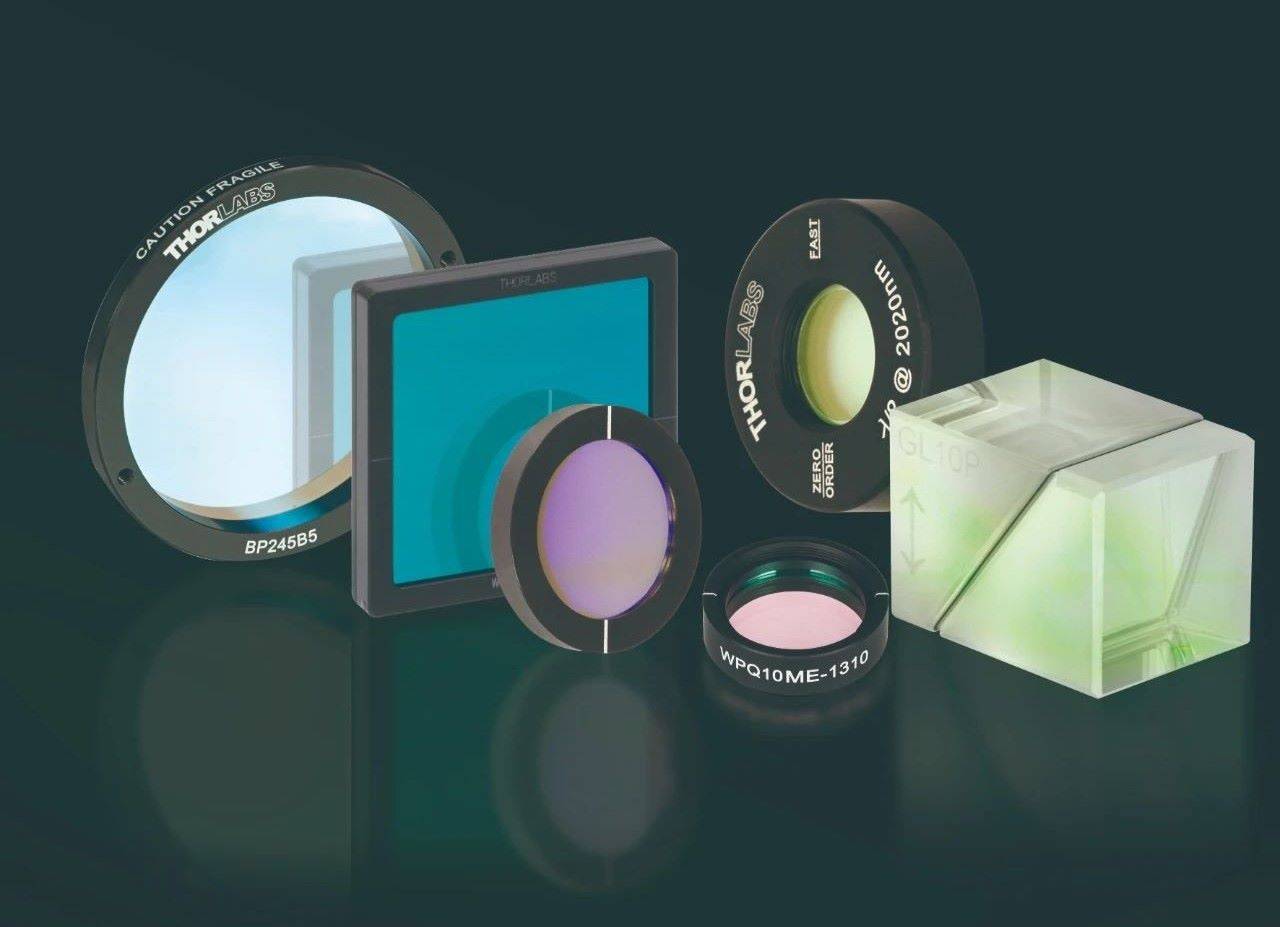
Filtres de polarisation
Les filtres de polarisation transmettent sélectivement les ondes lumineuses dont les vecteurs de champ électrique sont alignés dans une direction particulière. Ce processus implique des changements de l'état de polarisation de la lumière en fonction de la longueur d'onde. Par exemple, les polariseurs linéaires ne laissent passer que les ondes lumineuses ayant une orientation spécifique du champ électrique, filtrant efficacement les autres orientations. Cette propriété est largement utilisée dans des applications telles que les écrans LCD, les films en 3D et les lunettes de soleil polarisantes pour réduire l'éblouissement.
Filtres à diffraction
Les filtres de diffraction, quant à eux, fonctionnent en utilisant le principe de réfraction et de diffraction. Ces filtres utilisent souvent des prismes ou des réseaux pour disperser la lumière en ses différentes longueurs d'onde. Le réseau de diffraction, par exemple, divise la lumière en un spectre par le biais de l'interférence et de la diffraction, ce qui permet d'analyser la composition spectrale de la lumière. Cette technique est fondamentale en spectroscopie et dans d'autres systèmes optiques analytiques où la sélection précise des longueurs d'onde est essentielle.
Les filtres de polarisation et de diffraction sont des outils indispensables dans l'ingénierie optique, offrant des capacités uniques qui améliorent les performances et la fonctionnalité de divers dispositifs et systèmes optiques.
Filtres acousto-optiques
Les filtres acousto-optiques exploitent le phénomène de diffraction de Bragg, où les ondes sonores interagissent avec la lumière pour filtrer sélectivement des gammes de fréquences spécifiques. Cette interaction se produit lorsqu'une onde acoustique, généralement générée par un transducteur piézoélectrique, se propage dans un milieu tel qu'un cristal ou du verre. Les ondes sonores créent une variation périodique de l'indice de réfraction du matériau, formant ainsi un réseau de diffraction dynamique.
Lorsque la lumière traverse ce milieu modulé, elle subit une diffraction dont l'angle dépend de la longueur d'onde de la lumière et de la fréquence de l'onde sonore. En contrôlant précisément la fréquence de l'onde acoustique, les filtres acousto-optiques peuvent être réglés pour fonctionner dans des plages de fréquences extrêmement étroites, ce qui les rend très efficaces pour les applications exigeant une précision spectrale.
Le fonctionnement des filtres acousto-optiques peut être résumé en trois étapes clés :
- Génération d'ondes acoustiques: Un transducteur piézoélectrique convertit un signal électrique en une onde acoustique, qui se propage ensuite dans le milieu.
- Diffraction de Bragg: L'onde acoustique module l'indice de réfraction du milieu, créant un réseau dynamique qui diffracte la lumière incidente.
- Sélection de la fréquence: L'angle de diffraction dépend de la fréquence de l'onde acoustique, ce qui permet une sélection précise de la gamme de fréquences souhaitée.
Cette méthode de sélection de la fréquence est particulièrement avantageuse dans des applications telles que les télécommunications, où la capacité de filtrer des canaux spécifiques dans les systèmes de multiplexage par répartition en longueur d'onde (WDM) est cruciale. En outre, les filtres acousto-optiques sont utilisés en spectroscopie pour leur capacité à fournir une analyse spectrale à haute résolution.
Applications des filtres optiques
Élimination de la lumière indésirable
Les filtres optiques jouent un rôle crucial dans l'élimination de la lumière indésirable dans divers domaines, améliorant ainsi la sécurité et les performances. Ces filtres sont indispensables pour protection des yeux Ils protègent les yeux des rayons ultraviolets (UV) et infrarouges (IR) nocifs, évitant ainsi les dommages et l'inconfort à long terme. Dans le domaine du contrôle thermique les filtres optiques aident à gérer la chaleur en bloquant ou en transmettant sélectivement des longueurs d'onde spécifiques, assurant ainsi une régulation optimale de la température dans les environnements sensibles.

Dans le domaine de la microscopie à fluorescence Les filtres optiques sont essentiels pour isoler le signal de fluorescence de la lumière de fond, améliorant ainsi la clarté et la résolution de l'image. Cette application est particulièrement importante dans la recherche biologique et médicale, où l'observation et l'analyse précises des marqueurs fluorescents sont essentielles.
| Application | Description de l'application |
|---|---|
| Protection des yeux | Protège les yeux des rayonnements UV et IR, évitant ainsi les dommages et l'inconfort. |
| Contrôle thermique | Gère la chaleur en bloquant ou en transmettant sélectivement des longueurs d'onde spécifiques. |
| Microscopie à fluorescence | Améliore la clarté de l'image en isolant les signaux de fluorescence de la lumière de fond. |
Applications dans le domaine de la fibre optique
Les filtres optiques jouent un rôle crucial dans les systèmes à fibres optiques, en particulier dans les domaines suivants l'aplanissement du gain et séparation des canaux à l'intérieur multiplexage par répartition en longueur d'onde (WDM) (WDM). L'aplatissement du gain implique l'utilisation de filtres pour garantir que le spectre de gain des amplificateurs optiques reste uniforme sur toutes les longueurs d'onde, évitant ainsi la distorsion du signal et améliorant les performances globales du système. Cela est essentiel pour maintenir une force et une qualité de signal constantes sur toute la largeur de bande du réseau de fibres optiques.
Dans les systèmes WDM, les filtres optiques permettent de séparer plusieurs canaux de données qui sont transmis simultanément sur une seule fibre optique. Chaque canal fonctionne à une longueur d'onde distincte et les filtres sont utilisés pour isoler ces longueurs d'onde, garantissant que les données d'un canal n'interfèrent pas avec celles d'un autre. Cette capacité est essentielle pour accroître la capacité de transport de données des réseaux de fibres optiques, ce qui permet de transmettre de grandes quantités d'informations sur de longues distances avec un minimum de pertes.
En outre, les filtres optiques utilisés dans les applications de fibre optique sont conçus pour répondre à des défis spécifiques tels que la dispersion chromatique et effets non linéaires qui peuvent dégrader l'intégrité du signal. En sélectionnant soigneusement et en optimisant les caractéristiques de ces filtres, les ingénieurs peuvent atténuer ces problèmes, ce qui permet d'obtenir des systèmes de communication plus fiables et plus efficaces.
Applications laser
Dans le domaine de la technologie laser, les filtres optiques jouent un rôle essentiel dans l'obtention d'un réglage précis de la longueur d'onde, dans le maintien d'un fonctionnement monomode et dans la suppression efficace des longueurs d'onde indésirables. Ces fonctionnalités sont cruciales pour améliorer les performances et la fiabilité des systèmes laser dans diverses applications.
Accord de la longueur d'onde
Les filtres optiques permettent un réglage fin des longueurs d'onde des lasers, ce qui est essentiel pour aligner la sortie du laser sur des exigences spectrales spécifiques. Cette capacité est particulièrement importante dans la recherche scientifique, les diagnostics médicaux et les télécommunications, où un contrôle précis de la longueur d'onde est nécessaire pour obtenir des performances optimales.
Fonctionnement en mode unique
Le maintien d'un fonctionnement monomode est essentiel pour assurer la cohérence et la stabilité des faisceaux laser. Les filtres optiques permettent d'isoler un mode longitudinal unique en éliminant les autres modes, ce qui améliore la qualité de la sortie du laser. Ceci est particulièrement important dans des applications telles que la communication par fibre optique, où des signaux stables et de haute qualité sont primordiaux.
Suppression des longueurs d'onde indésirables
Les longueurs d'onde indésirables peuvent introduire du bruit et réduire l'efficacité des systèmes laser. Les filtres optiques sont utilisés pour bloquer sélectivement ces longueurs d'onde, améliorant ainsi le rapport signal/bruit et les performances globales du laser. Cet aspect est crucial dans des applications allant de la chirurgie au laser à la découpe industrielle, où la précision et la clarté ne sont pas négociables.
En résumé, les filtres optiques sont indispensables dans les applications laser, car ils offrent la précision et le contrôle nécessaires pour répondre aux exigences rigoureuses de diverses industries.
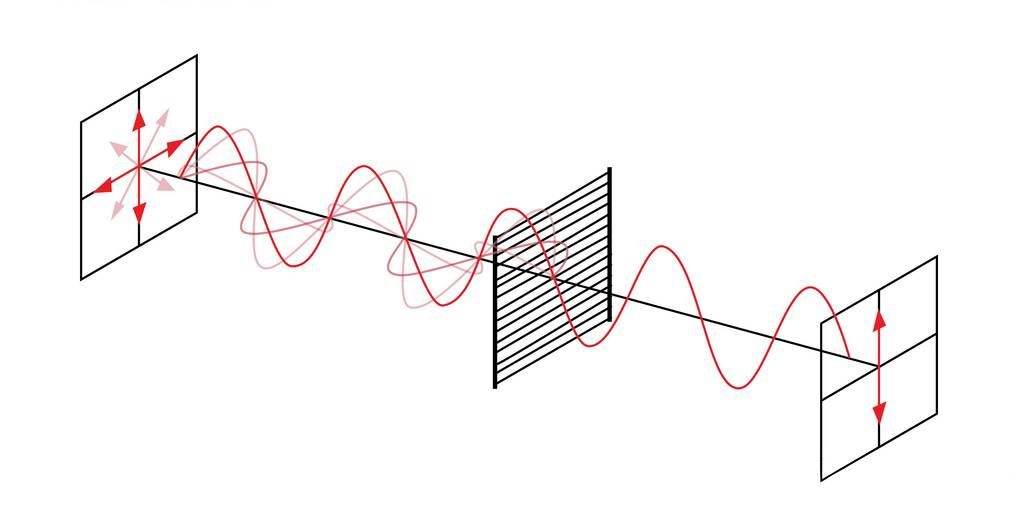
Analyse spectrale
L'analyse spectrale est une application critique des filtres optiques, en particulier dans le domaine de l'analyse des signaux. Ce processus implique la combinaison stratégique de filtres accordables et de photodétecteurs à large bande pour disséquer et interpréter les spectres complexes des signaux lumineux.
Les filtres accordables, tels que ceux basés sur les principes acousto-optiques ou d'interférence, permettent la transmission sélective de longueurs d'onde spécifiques. En ajustant ces filtres, les chercheurs peuvent isoler et examiner des composantes spectrales particulières, ce qui permet d'obtenir des informations détaillées sur la composition et les caractéristiques de la source lumineuse.
Les photodétecteurs à large bande, quant à eux, sont essentiels pour capturer l'intégralité du spectre filtré. Ces dispositifs convertissent les signaux lumineux en signaux électriques, qui peuvent ensuite être traités et analysés à l'aide de logiciels sophistiqués. La synergie entre les filtres accordables et les photodétecteurs à large bande permet de mesurer et d'interpréter avec précision les données spectrales, ce qui permet d'identifier et de quantifier diverses caractéristiques spectrales.
Cette combinaison est particulièrement précieuse dans des domaines tels que la spectroscopie, où la capacité d'analyser et de comprendre le contenu spectral de la lumière est cruciale. Que ce soit dans les laboratoires de recherche ou dans l'industrie, l'analyse spectrale à l'aide de filtres optiques constitue un outil puissant pour découvrir les détails cachés dans les signaux lumineux.
Produits associés
- Filtre de prélèvement PTFE
- Filtre-presse hydraulique à membrane pour laboratoire
- Ballon en PTFE/Flacon à trois cols en PTFE/Flacon à fond rond en PTFE
- Agitateurs de laboratoire haute performance pour diverses applications
- Soupape d'air en PTFE
Articles associés
- Révolutionnez votre analyse spectroscopique avec la presse à pellets FTIR
- Distillation moléculaire : Une technologie efficace de séparation et de purification
- Pelle en PTFE : Un guide complet sur ses utilisations, ses avantages et ses applications
- Supports de nettoyage en PTFE : Le guide ultime pour le nettoyage et le séchage du matériel de laboratoire
- Joints en PTFE : le gardien invisible de la prévention des fuites industrielles

